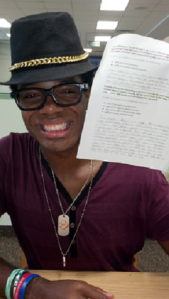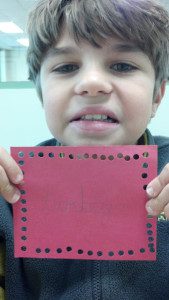“In studies, kids who practice handwriting do better at reading and spelling. The reason? Some experts believe that forming letters by hand while learning sounds activates reading circuits in the brain that promote literacy. Keyboarding on a computer, by contrast, hasn’t been shown to improve reading.”
The Unexpected Connection Between Handwriting and Learning to Read
By Sheldon H. Horowitz, EdD on Sep 24, 2018 https://www.understood.org/static/articles/html/copier.html?v=ed55756f8adccecc1c6897116ef1b47a#https://www.understood.org/en/community-events/blogs/expert-corner/2018/09/24/the-unexpected-connection-between-handwriting-and-learning-to-read

When I was a kid, writing meant one of two things: You either wrote by hand with a pen or pencil, or you punched keys on a typewriter. That was it. Mistakes were tough to fix and revisions hard to make. If you needed to change something, you had to carefully erase (while trying not to smudge or tear the paper) or use correction fluid or tape. And it never looked quite right.
For students with language-based learning differences like dyslexia, this caused lots of frustration. The mechanics of writing got in the way of expression. It became a big source of anxiety for kids.
Then assistive technology for writing arrived. We now have computers with autocorrect, dictation, word prediction and so much more. Kids can revise papers without an eraser or correction tape. It’s easier for them to express themselves.
All this technology has led to something else, too: Less focus on handwriting. And that has an unexpected impact on language and literacy. Less handwriting practice can make it harder for kids to learn to read.
Everyone learns best when information is presented in multiple ways. That’s especially true for kids with learning and thinking differences. We call this multisensory learning.
Handwriting is a multisensory activity. As you form each letter, your hand shares information with language processing areas in your brain. As your eyes track what you’re writing, you engage these areas. The same goes if you say letter sounds and words when you write.
Research shows there’s something special about language development and the act of handwriting. In studies, kids who practice handwriting do better at reading and spelling. The reason? Some experts believe that forming letters by hand while learning sounds activates reading circuits in the brain that promote literacy.
Keyboarding on a computer, by contrast, hasn’t been shown to improve reading. Yes, keyboarding can be a lifeline and a relief for kids with writing issues. It allows them to express themselves and have more success in school. But it’s not a substitute for handwriting instruction and practice, especially in the early grades.
I don’t think the challenge for teachers and parents is to decide “does handwriting matter?” It does and always will. The challenge is finding the right approach for children who struggle with writing.
Lots of kids experience real physical discomfort when holding a pencil. They complain of their fingers or arm hurting, or their hand getting tired. The sensation of gripping may be distracting. And there’s the emotional toll when kids are asked over and over “What does that say?” about the letters and words they’ve drawn. With all this, it’s tempting to ditch the pens and pencils and only use keyboards or dictation.
In Reader, Come Home: The Reading Brain in a Digital World, Maryanne Wolf talks about how technology has led to more skimming rather than reading slowly and carefully. She talks about the benefits of “cognitive patience.” And she reminds us that reading quickly isn’t what makes someone a good reader.
I think something similar holds true for handwriting.
Just because keyboarding is faster doesn’t mean it’s better. Yes, students with dyslexia and other learning differences may be able to write more easily on a computer than by hand. But that doesn’t mean we should abandon handwriting.
My view: Let’s give our kids every opportunity to thrive as readers and writers. They can use screens and devices and all sorts of technology. But let’s also keep pens and pencils handy. Doing the slow, often difficult work of practicing handwriting can help kids become better readers and writers.
Check out six multisensory techniques to teach handwriting. Download free handwriting tools, like bold line paper and mazes for tracing. And learn how a student used assistive technology to help handle college writing.
Share

About the Author
Sheldon H. Horowitz, EdD is senior director of learning resources and research at the National Center for Learning Disabilities.




 while learning to read and doing handwriting, we were at a loss.After listening carefully to our concerns, Marla gave her an evaluation and we were amazed at how thorough it was! She discovered midline issues we didn’t even know existed and continued by helping us understand visual loss, auditory processing disorder and disgraphia. She handled our numerous questions with ease and even recommended some books to help us.
Rose has been in session with Marla for a few months and she loves it. She can’t wait to do her “homework” during the week and constantly tells us how much fun OT is! We have seen a huge improvement in such a short time. Rose has gained control of her visual loss and the consequences for her reading and handwriting have been tremendous. Marla is very kid oriented and we have seen her challenge Rose but is always encouraging and supportive. We are very grateful for her knowledge and experience as our daughter’s occupational therapist.
while learning to read and doing handwriting, we were at a loss.After listening carefully to our concerns, Marla gave her an evaluation and we were amazed at how thorough it was! She discovered midline issues we didn’t even know existed and continued by helping us understand visual loss, auditory processing disorder and disgraphia. She handled our numerous questions with ease and even recommended some books to help us.
Rose has been in session with Marla for a few months and she loves it. She can’t wait to do her “homework” during the week and constantly tells us how much fun OT is! We have seen a huge improvement in such a short time. Rose has gained control of her visual loss and the consequences for her reading and handwriting have been tremendous. Marla is very kid oriented and we have seen her challenge Rose but is always encouraging and supportive. We are very grateful for her knowledge and experience as our daughter’s occupational therapist.

